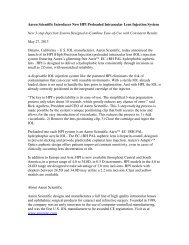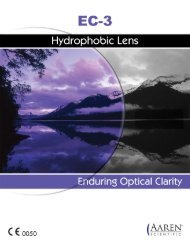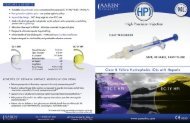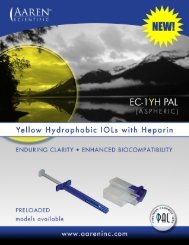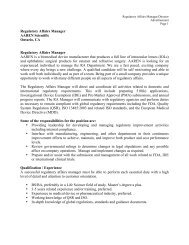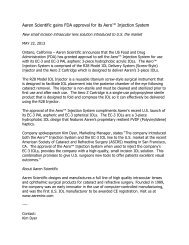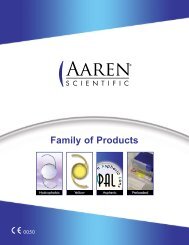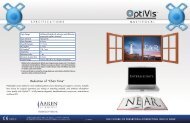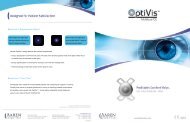Hydrophobic Acrylic IOLs: A Primer - Aaren Scientific
Hydrophobic Acrylic IOLs: A Primer - Aaren Scientific
Hydrophobic Acrylic IOLs: A Primer - Aaren Scientific
Create successful ePaper yourself
Turn your PDF publications into a flip-book with our unique Google optimized e-Paper software.
COVER STORY<strong>Hydrophobic</strong><strong>Acrylic</strong> <strong>IOLs</strong>: A <strong>Primer</strong>The material properties and designs of different manufacturers influence surgical results.BY STEELE MCINTYRE, MD; LILIANA WERNER, MD, PHD; AND NICK MAMALIS, MDThe 2003 American Society of Cataract andRefractive Surgery (ASCRS) survey of practicestyles and preferences indicated that, since 1998,hydrophobic acrylic has been the preferred IOLoptic material. 1 Because surgeons appreciate the controlledunfolding characteristics associated with this classof materials, the popularity of hydrophobic acrylic lenseshas increased worldwide since their introduction.In the August 2010 issue of CRST Europe, Khiun F. Tjia,MD, of the Netherlands, summarized the characteristicsof hydrophobic acrylic <strong>IOLs</strong> that were new to theEuropean market. 2 As a follow-up, this article provides anoverview of biocompatibility issues related to hydrophobicacrylic lenses and a discussion of new material anddesign trends in IOL manufacturing (Table 1) and thepossible influences of these trends on surgical outcomes.This information was obtained through the correspondingmanufacturers and peer-reviewed literature. 3 The listof <strong>IOLs</strong> is not exhaustive; some were included in Dr. Tjia’sprevious publication. 2BIOCOMPATIBILITYUveal biocompatibility. This is defined as the reactionof the uvea to an IOL. In the body’s response to the presenceof a foreign body—the IOL—monocytes (lymphocytes)and macrophages migrate through blood vesselwalls to the aqueous humor and eventually to the <strong>IOLs</strong>urface. As this occurs, the monocytes and macrophagestransform—the monocytes into small round cells andmacrophages into epithelioid and foreign-body giantcells. These cells, which are responsible for the phagocytosisof debris, bacteria, and foreign material, reflect anatural immunologic process in a foreign-body reaction.Abela-Formanek et al 4 conducted a comparison of theuveal biocompatibility of hydrophilic acrylic (MemoryLens;Mentor Ophthalmics, Inc., Santa Barbara, California, andHydroview; Bausch + Lomb, Rochester, New York),hydrophobic acrylic (AcrySof; Alcon Laboratories, Inc.,Fort Worth, Texas, and Sensar AR40; Abbott MedicalOptics Inc., Santa Ana, California), and hydrophobic silicone<strong>IOLs</strong> (CeeOn 920; formerly Pharmacia Corp.,Peapack, New Jersey; technology since purchased byAbbott Medical Optics Inc.). The researchers found thatthe highest incidence of late foreign-body cell reactionwas with hydrophobic acrylic <strong>IOLs</strong> (AcrySof, 30%; SensarAR40, 17%), followed by the hydrophilic acrylic(MemoryLens, 8%; Hydroview, 4%) and silicone (CeeOn,4%; CeeOn 911A, 0%) <strong>IOLs</strong>. A low-grade cellular reactionwas clinically insignificant in all cases. Giant cells generallydegenerate and detach from IOL surfaces, and only anacellular proteinaceous membrane is left around the IOL,isolating it from the surrounding ocular tissues.Capsular biocompatibility. Capsular biocompatibilityhas two components, the reaction of lens epithelial cells(LECs) and the reaction of the capsule to IOL materialand design. Abela-Formanek et al 4 also evaluated LECoutgrowth, anterior capsular opacification (ACO), andposterior capsular opacification (PCO) outcomes in thesame lenses enumerated above. The highest incidence ofLEC outgrowth on the anterior IOL surface (originatingfrom the anterior capsular rim) was in the hydrophilicacrylic group (Hydroview, 85%; MemoryLens, 27%), followedby the hydrophobic acrylic (AcrySof, 4%; SensarAR40, 3%). No LECs were found on the anterior surfaceof the silicone <strong>IOLs</strong>. The difference among IOL groupswas significant (P=.0001). ACO was more predominant inthe hydrophobic IOL groups.Other studies have shown more fibrosis of the anteriorcapsule and ACO in association with silicone <strong>IOLs</strong>, especiallyplate-haptic designs. 5 Additionally, some studies 4,6have indicated that PCO was lower with square-edge–design<strong>IOLs</strong>, regardless of IOL material.DESIGN FEATURES AFFECT PCOThe preventive PCO effect associated with the squareedge may be due to the mechanical barrier effect, 7 theMARCH 2011 CATARACT & REFRACTIVE SURGERY TODAY EUROPE 39
COVER STORYcontact inhibition of migrating LECs at the capsular bendcreated by the edge, 8 the higher pressures exerted by<strong>IOLs</strong> with a square-edged optic profile on the posteriorcapsule, 9 or combinations of these factors.Current hydrophobic acrylic <strong>IOLs</strong> generally have asquare optic edge. However, not all square edges are thesame. In an experimental study including 19 hydrophobicacrylic lenses, the area above the posterior-lateral edge ofeach IOL was measured to determine the deviation froma perfect square. 10 Variation was found not only amongthe IOL designs but also among different powers of thesame IOL. This type of evaluation can help manufacturersoptimize their <strong>IOLs</strong>’ optic edges. For example, HoyaCorp. (Tokyo) modified the edge profile of several AF-1models after results of a single-surgeon prospective felloweyecomparison showed that the PCO rate was significantlyhigher with the AF-1 YA-60BB IOL than with theAcrySof SN60AT. 11 The study was based on results in 36patients who were followed for 24 months. The result isnot surprising, considering the differences in edge designbetween these lenses in the amount of area deviatingfrom a perfect square (AF-1, 329.7 µm 2 ; SN60AT [20.00D], 97.2 µm 2 ). 10 Hoya made several manufacturingchanges, including variations in polishing process, anddifferent prototypes were sent for evaluation. 12 The areadeviating from a perfect square in the current Hoya AF-1family now measures 39.1 µm 2 . Such quantification of thearea deviating from a perfect square—and thereforeassessment of the sharpness of the posterior opticedge—is not available for many new models ofhydrophobic acrylic lenses.Another design trend observed in hydrophobic acrylicIOL manufacturing is the availability of new <strong>IOLs</strong> in a onepieceplatform. Most prospective, randomized studieshave shown no statistically significant differences betweenone- and three-piece hydrophobic acrylic <strong>IOLs</strong> in terms ofPCO rate; 13 however, it has been shown that, wheneverPCO occurs with one-piece designs, it has the tendencyto start at the level of the optic-haptic junction. 7Several manufacturers have modified the optic-hapticjunctions of their <strong>IOLs</strong> to obtain a continuous 360ºsquare edge. In one study, patients were implanted with aTAKE-HOME MESSAGE• Lens materials must be both uveal and capsularbiocompatible.• Most hydrophobic acrylic <strong>IOLs</strong> have a square edge;however, the deviation from a perfect square can varydepending on IOL design and IOL power.• The tendency for glistenings varies depending on the IOLmaterial, manufacturing technique, and packaging process.one-piece hydrophobic acrylic IOL with an interruptedoptic edge (AcrySof) in one eye and a newer one-piecehydrophobic acrylic IOL with a continuous optic edge(Tecnis 1-Piece; Abbott Medical Optics Inc.) in theother. 14 Two years after surgery, the extent and density ofPCO were significantly greater in eyes with the AcrySofIOL that those with the Tecnis IOL.BLUE-LIGHT FILTERING CHROMOPHORESSome hydrophobic acrylic lenses incorporate blue-lightfiltering chromophores, as it has been suggested thatblue-light–filtering <strong>IOLs</strong> protect lipofuscin-containingretinal pigment epithelial cells from blue-light damage. 15There is indirect evidence suggesting that blue-light filtersmay result in a reduced risk of development or progressionof macular degeneration, but the value of these yellowchromophore–containinglenses is not fully understood.Potential side effects of constantly filtering blue light mayinclude negative impacts on color vision, night vision, andsleep and circadian rhythms. 16One photochromic lens (Matrix Aurium; Medennium,Irvine, California) turns yellow when exposed to ultraviolet(UV) light because the blue light is absorbed. The lensbehaves as a standard UV-absorbing IOL in an indoorenvironment; the optic remains colorless, and there is nofiltering of blue light. This innovative concept theoreticallyeliminates the potential side effects of yellow <strong>IOLs</strong> andprovides patients with the potential for improved nightvision after cataract surgery, additional protection of themacula against blue light in daylight conditions, andimproved contrast sensitivity (as demonstrated in clinicalstudies with yellow lenses). 17In a rabbit study conducted in our laboratory, thelong-term biocompatibility and photochromic stabilityof the photochromic IOL were evaluated under extendedUV light exposure (simulating 20 years of exposure). 17The photochromic change was found to be reversible (ie,the optic returned to its colorless state after discontinuationof UV light projection) and reproducible (ie, thephotochromic change was observed at different timepoints in the clinical follow-up). Additionally, the photochromicproperty of the optic material remained stableand was present and unchanged 12 months after implantation.The rabbit eyes exhibited clinical and histopathologicchanges that are normally expected in this model,and there was no difference between study and controleyes in terms of biocompatibility.GLISTENINGSGlistenings are fluid-filled microvacuoles that formwithin an IOL optic when the lens is in an aqueous environment.3 They can be observed with any type of IOL,40 CATARACT & REFRACTIVE SURGERY TODAY EUROPE MARCH 2011
COVER STORYalthough they have mainly been described in associationwith hydrophobic acrylic lenses. Experimental and clinicalstudies suggest that different hydrophobic acryliclenses exhibit different tendencies for the occurrence ofglistenings. Factors that may influence their formationinclude IOL material composition, IOL manufacturingtechnique, IOL packaging, patient-associated conditionssuch as glaucoma or those leading to breakdown of theblood-aqueous barrier, and concurrent use by the patientof ocular medications.The exact impact of glistenings on postoperative visualfunction and an understanding of their evolution in thelate postoperative period remains a matter of controversy,partly because IOL explantation due to glistenings israrely reported. Although it is likely that each hydrophobicacrylic IOL exhibits different tendencies toward glisteningformation, no peer-reviewed articles are currentlyavailable for the <strong>IOLs</strong> listed in Table 1. Most of the peerreviewedliterature describes glistening formation, incidence,and severity in the AcrySof material; 3 a relativelysmall number of articles and presentations evaluate glisteningformation in the Acryfold VA60CA/CB (HoyaCorp.), Acrylmex (Ophthalmic Innovations International,Inc.; now <strong>Aaren</strong> <strong>Scientific</strong>, Ontario, California), SensarAR40(e), and XACT (Advanced Vision Science, Inc.,Goleta, California) <strong>IOLs</strong>. 3In one Japanese clinical study of glistenings, 18 74 eyeswere implanted with the AcrySof SA30AL (n=17), theAcryfold VA60CB (n=37), or the Sensar AR40e (n=20).Follow-up ranged from 6 to 18 months. Slit-lamp examinationshowed the presence of grade 1C glistenings(Miyata classification) in 35.3% of the AcrySof <strong>IOLs</strong> and62.1% of the Acryfold <strong>IOLs</strong> but in 0% of the Sensar <strong>IOLs</strong>.Hoya investigated the reports of glistenings (a total of 29)in its early IOL models VA60CA and VA60CB, which werenever commercially released outside of Japan and weresubsequently discontinued. Improvements were implementedin the polymerization and cleaning processes ofthe company’s lenses, and continued monitoring ofthe manufacturing processes and a low level of customercomplaints indicate that these changes havebeen effective.STORAGE MEDIA CAN CAUSE GLISTENINGSAccording to information contained in the US Foodand Drug Administration (FDA) Summary of Safety andEffectiveness Data and on IOL labeling (obtained throughthe manufacturer, Advanced Vision Science, Inc.), theXACT IOL was originally packaged in 10.0% saline. Thepresence of glistenings was reported in 40 eyes (40patients) between 1 week and 1 month after surgery,with decreased density at each visit thereafter. 3 No differencesin contrast sensitivity were observed between thestudy and control eyes, except for a clinically insignificantdifference in contrast sensitivity detected in the highestspatial frequencies at 1 month. It was postulated that,after implantation, the osmotic differential between theIOL and aqueous humor caused more water to beabsorbed into the IOL optic, resulting in the appearanceof glistenings. However, a change of hydration/storagemedia from 10.0% to 0.9% saline was implemented, andlaboratory testing demonstrated elimination of the glistenings.This was confirmed in an additional clinical trialconducted in the Dominican Republic and Germany, thedata from which were included in the FDA marketingapplication for the IOL. 19 In this study, 172 eyes (142patients) were examined at least once between 1 and 6months, and 123 eyes (101 patients) were examined atleast once between 6 months and 2 years. No glisteningswere observed at any time.The XACT IOL was approved for use in the UnitedStates in February 2009 (subsequently licensed to Bausch+ Lomb, Rochester, New York) and in Japan in 2008(trade name, Santen Eternity). This hydrophobic acrylicIOL, packaged in 0.9% saline, is also gamma sterilized.NO REPORTED GLISTENINGSOther <strong>IOLs</strong> with no reported glistenings include theAurolab lens (Aurolab, New Delhi, India), the AcrylmexIOL (three- and one-piece models EC-3 and EC-1Y,respectively), Hanita hydrophobic acrylic lenses (HanitaLenses, Kibbutz Hanita, Israel), and the Artis (Cristalens,France).Aurolab. In a study of 120 patients implanted with theAurolab lens at the Aravind Eye Hospital in Madurai,India, BCVA was 6/12 or better, and no eye had IOLinducedintraocular pressure increase (informationobtained from the manufacturer). Decentration was notsignificant, and IOL tilt, discoloration, or opacity was notreported. However, adverse events included one case ofiritis and one case of secondary surgical intervention dueto haptic damage.Acrylmex. Two European clinical studies presented atthe 2009 ASCRS meeting 20,21 showed the absence of glisteningsat 1 year after implantation of the Acrylmex IOL.The first study included at least 10 cases with a minimumfollow-up of 18 months.Hanita hydrophobic acrylic lenses. These <strong>IOLs</strong> aremanufactured with a hydrophobic acrylic materialprovided by Benz Research. The material supplierassesses a glistenings severity index for each batch ofmaterial for quality assurance. <strong>IOLs</strong> immersed in salinewere observed for 6 months; the severity index wassignificantly lower than that of the AcrySof lensesMARCH 2011 CATARACT & REFRACTIVE SURGERY TODAY EUROPE 41
COVER STORYTABLE 1. CHARACTERISTICS OF SOME CURRENTLY AVAILABLE HYDROPHOBIC IOLSIOL/manufacturer (country) Material composition* RefractiveindexThree-piece and one-pieceAcrySof/Alcon Laboratories, Inc. (US)Copolymer of phenylethyl acrylate and phenylethylmethacrylate, crosslinked with butanediol diacrylateGlass transitiontemperature1.555 14.0–15.5°CSensar AR40 and AR40e one-pieceTecnis/Abbott Medical Optics Inc. (US)AF-1 series iMics 1/Hoya Surgical Optics(Japan)Copolymer of ethyl acrylate, ethyl methacrylate, and 2,2,2-trifluoroethyl methacrylate, crosslinked with ethylene glycoldimethacrylateCrosslinked copolymer of phenylethyl methacrylate andn-butyl acrylate, fluoroalkyl methacrylate1.470 12.21±0.40°C1.520 11°CXACT/Advanced Vision Science, Inc.(US)Copolymer of hydroxyethyl methacrylate, polyethylene glycolphenyl ether acrylate, and styrene, crosslinked with ethyleneglycol dimethacrylate1.540 15–20°CHP 757SQ/Aurolab (India)Acrylmex/Ophthalmic InnovationsInternational (now <strong>Aaren</strong> <strong>Scientific</strong>)(US)Matrix <strong>Acrylic</strong> Aurium/Medennium(US)Copolymer of ethylacrylate and ethylmethacrylate,crosslinked with a difunctional acrylate/methacrylateTerpolymer of butyl acrylate, ethyl methacrylate, and N-benzyl-N-isopropylpropenamide, crosslinked with ethyleneglycol dimethacrylatePoly(2-phenyloxyethyl acrylate), crosslinked with phenylcontainingdimethacrylate (IOL has a photochromic chromophore)1.470 11 ±2°C1.490 NP1.560 NPHydromax/Carl Zeiss Meditec(Germany)Homopolymer of 2-phenoxy ethyl acrylate, crosslinked withethoxylated (2) bisphenol A dimethacrylate1.560 16°CL450/Wavelight/Oculentis (Germany) NP 1.500 NPSeeLens HP/Hanita (Israel)Mediflex/Mediphacos (Brazil)Lotus Classic 63D and 63G/MorcherGmbH (Germany)Ethoxyethyl methacrylate and methyl methacrylate withincorporated violet-filtering chromophoreCopolymer of acrylate/methacrylate with blue-light filteringchromophore nonaromatic acrylic rubber1.480 10ºC1.480 5ºCNP 1.520 NPArtis Luxiol/Cristalens (France) NP 1.545 11°CLumen Siloe/Cristalens (France) NP 1.480 10ºCBasis/Special Z/1stQ (Germany) NP 1.470 NPNex Load/Domilens (Germany) NP 1.520 NPDomicryl M100/Domilens (Germany) NP 1.510 NP860FAB(Y) and Biflex HB/Medicontur(Hungary)NP 1.470 NPLuna/Ophtec (Netherlands) NP 1.480 NP* All models have ultraviolet light blockersNP = not provided42 CATARACT & REFRACTIVE SURGERY TODAY EUROPE MARCH 2011
COVER STORYWater content Contact angle in Packaging Manufacturing method FDA approvalwater
COVER STORY(personal communication with Benz Research &Development).Artis. Results are available for 20 consecutive eyesimplanted with the Artis (follow-up, 60 days). These <strong>IOLs</strong>were implanted in five centers by five surgeons through asub-2–mm incision (1.7 mm). The refractive results werewithin ±0.50 D of intended correction and remained stable.No glistenings or any form of IOL opacification wasobserved. Due to the overall design—four haptic componentswith 5º angulation and a square optic edge, includingat the optic-haptic junctions—the IOL did not induceovalization of the capsular bag. Posterior capsular contactwith the optic was noted between 8 and 15 dayspostoperatively; thus far, no lens epithelial cell migrationhas been detected behind the IOL optic, and the totallytransparent anterior capsule is not attached to the IOL’santerior optic surface.CALCIFICATIONPostoperative surface or intraoptic deposition of calciumphosphate has been described in association withhydrophilic acrylic lenses. 22 The four major designsinvolved in the problem are the Hydroview (Bausch +Lomb), the MemoryLens, the SC60B-OUV (MedicalDevelopmental Research, Inc., Clearwater, Florida), andthe Aqua-Sense (<strong>Aaren</strong> <strong>Scientific</strong>).Calcium phosphate deposits have also been reportedto occur on the posterior optic surface of silicone lensesimplanted in eyes with asteroid hyalosis. 22 To the best ofour knowledge, no confirmed case of calcification ofhydrophobic acrylic lenses is described in the literature;therefore, postoperative calcification does not appear tobe an issue with hydrophobic acrylic materials.CONCLUSIONVarious hydrophobic acrylic <strong>IOLs</strong> have been launchedin the international market, with manufacturing trendsthat include one-piece platforms, a 360º square posterioroptic edge with attention to the barrier effect at thelevel of the optic-haptic junctions, and incorporation ofblue-light–filtering chromophores. A photochromicIOL, filtering blue light only under photopic conditions,is also available.All hydrophobic acrylic lenses are not manufacturedfrom the same materials or using the same processes.Therefore, each lens exhibits different characteristics,including refractive index, water content, and tendencyfor glistenings formation. In terms of PCO formation, itappears that the square posterior optic edge is the mostimportant IOL design factor for prevention of this complication.However, all square edges in the market are notequally square. Only long-term clinical studies will indicateif there is superiority of a particular hydrophobicacrylic IOL over others. ■Nick Mamalis, MD, is a Professor and the Director of theIntermountain Ocular Research Center, John A. Moran EyeCenter, University of Utah, Salt Lake City. Dr. Mamalisstates that he is a paid consultant to Abbott MedicalOptics Inc. He may be reached at e-mail:nick.mamalis@hsc.utah.edu.Steele McIntyre, MD, is an ophthalmic research andpathology fellow at the Intermountain Ocular ResearchCenter, John A. Moran Eye Center, University of Utah, SaltLake City. Dr. McIntyre states that he has no financialinterest in the products or companies mentioned. He maybe reached at e-mail: steelemcintyre@hotmail.com.Liliana Werner, MD, PhD, is an Associate Professor andthe Co-Director of the Intermountain Ocular ResearchCenter, John A. Moran Eye Center, University of Utah, SaltLake City. Dr. Werner states that she is a paid consultant toPowervision and Abbott Medical Optics Inc. She may bereached at e-mail: liliana.werner@hsc.utah.edu.1.Leaming DV.Practice styles and preferences of ASCRS members—2003 survey.J Cataract Refract Surg.2004;30:892-900.2.Tjia KF.<strong>Hydrophobic</strong> acrylic <strong>IOLs</strong>.A new generation of these lenses is now available in Europe.Cataract & RefractiveSurgery Today Europe.2010;7:12-13.3.Werner L.Glistenings and surface light scattering in intraocular lenses. J Cataract Refract Surg.2010;36:1398-1420(Review).4.Abela-Formanek C, Amon M, Schild G, Schauersberger J, Heinze G, Kruger A.Uveal and capsular biocompatibility ofhydrophilic acrylic, hydrophobic acrylic, and silicone intraocular lenses.J Cataract Refract Surg.2002;28:50-61.5.Werner L, Pandey SK, Escobar-Gomez M,Visessook N, Peng Q, Apple DJ.Anterior capsule opacification:Ahistopathological study comparing different IOL styles. Ophthalmology.2000;107:463-471.6.Kohnen T, Fabian E, Gerl R, et al.Optic edge design as long-term factor for posterior capsular opacification rates.Ophthalmology.2008;115:1308-1314.7.Werner L, Mamalis N, Izak AM, et al.Posterior capsule opacification in rabbit eyes implanted with 1-piece and 3-piece hydrophobic acrylic intraocular lenses.J Cataract Refract Surg.2005;31:805-811.8.Nishi O, Nishi K.Preventing posterior capsule opacification by creating a discontinuous sharp bend in the capsule.JCataract Refract Surg.1999;25:521-526.9.Boyce JF, Bhermi GS, Spalton DJ, El-Osta AR.Mathematic modeling of the forces between an intraocular lens andthe capsule.J Cataract Refract Surg. 2002;28:1853-1859.10.Werner L, Müller M,Tetz M.Evaluating and defining the sharpness of intraocular lenses.Microedge structure ofcommercially available square-edged hydrophobic lenses. J Cataract Refract Surg.2008;34:310-317.11.Hancox J, Spalton DJ, Cleary G, et al.Fellow-eye comparison of posterior capsule opacification with AcrySofSN60AT and AF-1 YA-60BB blue-blocking intraocular lenses. J Cataract Refract Surg.2008;34:1489-1494.12.Werner L,Tetz M.Edge profiles of current available intraocular lenses and recent improvements.Touch Briefings.2009;74-76.13.Sacu S, Findl O, Menapace R, Buehl W,Wirtitsch M.Comparison of posterior capsule opacification between the 1-piece and 3-piece Acrysof intraocular lenses.Ophthalmology.2004;111:1840-1846.14.Nixon D,Woodcock M.Pattern of posterior capsule opacification models 2 years postoperatively with two singlepieceacrylic intraocular lenses.J Cataract Refract Surg.2010;36:929-934.15.Sparrow JR, Miller AS, Zhou J.Blue light-absorbing intraocular lens and retinal pigment epithelium protection invitro. J Cataract Refract Surg.2004;30:873-878.16.Mainster MA.Intraocular lenses should block UV radiation and violet but not blue light.Arch Ophthalmol.2005;123:550-555.17.Werner L, Abdel-Aziz S, Cutler-Peck C, et al.Accelerated 20-year sunlight exposure simulation of a photochromicfoldable intraocular lens in a rabbit model.J Cataract Refract Surg.2011;37(2):378-385.18.Yamamura T, Kazama S, Sasaki M, Shinzato E, Shima C.Glistening, surface irregularity, tilting and decentration ofacrylic intraocular lenses. IOL&RS (Japanese).2004;18:157-162.19.Tetz MR,Werner L, Schwahn-Bendig S, Batlle JF.Prospective clinical study to quantify glistenings in newhydrophobic acrylic IOL.Paper presented at:The ASCRS Symposium on Cataract, IOL, and Refractive Surgery; SanFrancisco; April 3-8, 2009.20.Amzallag T.One-year European results for the EC-3 hydrophobic clinical trial:Material clarity and visual outcomes.Paper presented at:The ASCRS Symposium on Cataract, IOL, and Refractive Surgery; San Francisco; April 3-8, 2009.21.Bosc JM.Initial impressions and early clinical results of a new single-piece hydrophobic yello acrylic IOL.Paperpresented at:The ASCRS Symposium on Cataract, IOL, and Refractive Surgery; San Francisco; April 3-8, 2009.22.Werner L.Causes of intraocular lens opacification or discoloration.J Cataract Refract Surg. 2007;33:713-726(Review).44 CATARACT & REFRACTIVE SURGERY TODAY EUROPE MARCH 2011



